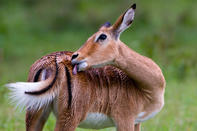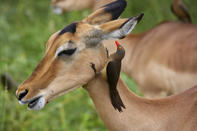Well Groomed
Impala typically inhabit ecotone regions, the transitional zone between two types of habitat, in this case between grassland and woodland. Ecotones characteristically carry high parasite loads and in this regard impala need to be able to combat the effects of excessive ticks on their bodies.

They employ several methods: Impala are fastidious groomers. They spend a large amount of time seeing to their personal hygiene evident in their shiny coats. For this job, they have modified teeth.
Their lower incisors are slightly loose in their sockets and splay open to provide a comb as the teeth pass through the impala’s coat, successfully hooking out dirt and parasites. Impala allo-groom in a reciprocal manner.
What this means is that one impala will groom another in the hard to reach places, usually the head and neck regions, and this will then be reciprocated by the groomed individual for almost exactly the same amount of time.
Outside Help

By Megan Emmett